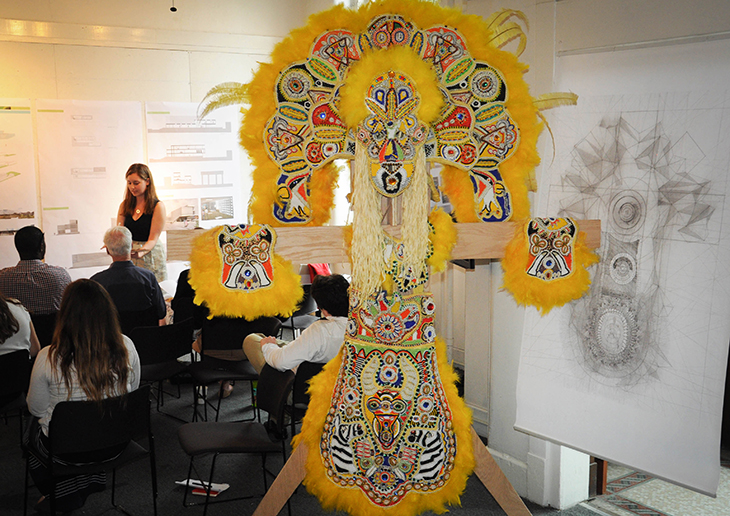Architecture studio and Mardi Gras Indians connect

One of six required studios in the School of Architecture, the Mardi Gras Indians Studio involves students in the art of cultural and community engagement. During the spring semester, students developed composite drawings of the Indians" beaded and feathered suits and also interacted with members of the tribes. (Photo by David Armentor)
Learning to create structures from wood and steel are typical lessons for architecture students, but at Tulane University, those students also have studied how beads and feathers create the complex and beautiful suits crafted by Mardi Gras Indians. It"s all part of a studio on The Art of Cultural and Community Engagement in the Tulane School of Architecture.
Forty students just completed the Mardi Gras Indians Studio during the spring semester, in its second year and being planned again for spring 2016, says architecture dean Kenneth Schwartz. (See the video, below.)
The studio focuses on development of a rigorous design process through direct engagement with the community in this case, members of Mardi Gras Indian tribes. African American members of the tribes design and create the suits, which are influenced by Native American ceremonial apparel, and parade at Carnival and other occasions. Former Tulane City Center director Maurice Cox has led the collaborative work with the Mardi Gras Indian organizations.
The tribes loaned two suits to the school, and students developed composite drawings of them, said Marcella del Signore, assistant professor and one of the studio leaders.
The service-learning class is a “way of connecting students with uniquely New Orleans culture and traditions as a source of inspiration,” del Signore says. Students conducted interviews with Mardi Gras Indian queens as part of their research, and visited homes of chiefs the week before Mardi Gras, to help create suits.
Later, students developed ideas for a building dedicated to Mardi Gras Indian culture.
This relationship with members of the cultural community reflects the service-learning mission. As Cox, who helped teach the class, says in the video below, “We"ve had students say, "We know there is no other architecture school in the country doing this, because it"s so unique to New Orleans." ⦠There is something really unique about the spirit of this place.”
“The studio is just a part of a larger, more profound relationship that we've forged with these culture bearers.”—Maurice Cox, adjunct professor, School of Architecture
